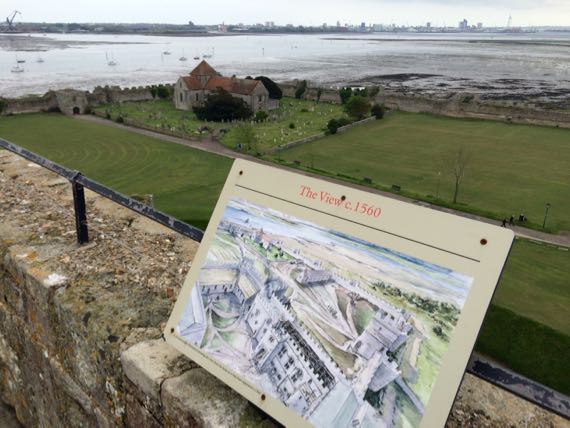(Pick your favorite title)
Friday, 15 May 2015
Here are your choices: “Soft verges,””Weak bridges,” or “No fly tipping.”
“Soft verges,” as you might guess, refers to the condition of the margin along the blacktop (ahem, macadam) of a road, when that margin is unpaved and ungraveled, and, when it’s been raining recently, like now, muddy, or liable to be muddy, even if it’s grass-covered. So, beware soft verges!
“Weak bridges” is info for drivers. It’s left up to you what to do with that knowledge. As near as we can tell, weak bridges may be…unsafe under heavy vehicles. Note the difference between this notification strategy and one where the sign says, for example, “no vehicles over 30,000 lbs,” or similar. The positon taken by the highway department is quite different….
I’ll let you continue to ponder the last one: “No fly tipping.”
Or perhaps you are more worldly than I, and KNOW what it means….
On to some stories for now….

This is a view from the substantially complete keep tower from a 12th-century castle…built inside the walls of a ca. late AD 200s Roman fort. Yes, these are the best-condition walls for a Roman fort standing today. In an odd twist of fate, the fort walls were finished, but the interior occupation was short-lived and not robust. The Romans built this, along with many other fortifications on both sides of the English Channel, to control piracy and brigandage during a period of unrest.
Centuries after the Romans left, and after some occupation by the intervening generations, the keep-tower I’m standing on to take this photo was built to replace the most protected corner of this large compound, along with ancillary rooms and structures. The castle occupies only one corner of the Roman fort. The church opposite also dates to the 12th-C, although we saw a grave with a death-date of about a century ago; it’s still in use. The keep area was modified several times through the Medieval period….
The roof of the keep (modern roof on 14th-C uppermost floor) has a small walkway all the way around, with access via a tight circular stair with worn narrow, pie-shaped stone steps (and a modern rope for a railing). I liked this view, beyond the walls and across revealed tidal flats, at modern boatyards.
On the list of who slept in this castle: King John of Magna Carta fame, who used it as a jumping-off place for his activities in Normandy….

Here’s the keep, anchoring the corner of the Roman fort-wall farthest from the harbor. There’s a moat around the fort, and another moat inside the Roman walls around the castle. THAT’s protection!
The keep was used as a prison in the 1800s, so despite excellent preservation of the Roman walls, the keep endured more alterations.
There’s plenty more known about the history of Portchester Castle, some of it on WikiPee. (I give you the name of this building here at the end, in keeping with the info-at-the-end pattern of the optional title explanations….)
Okay, that’s plenty of distraction. Back to the phrase “no fly tipping.” Here’s the only clue we had: such signs are near dumpsters, like in the back of a grocery store or fast-food restaurant parking lot.
So, is your choice “No fly tipping?”